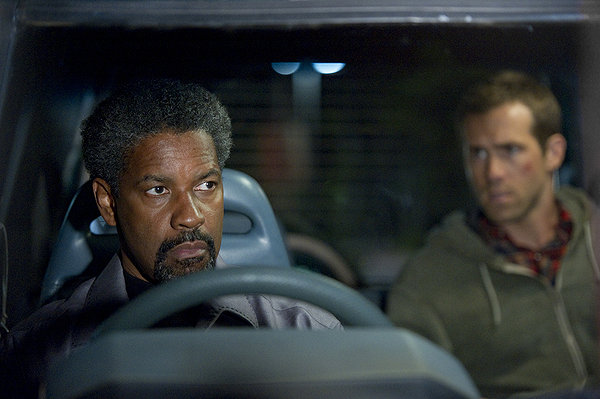Safe House Is Predictable (And Shaky) But Overall Solid
Safe House
Directed by Daniel Espinosa
Written by David Guggenheim
Universal, 2012
Safe House pits two actors who pretty much do the same job in every movie against each other. Denzel Washington, who is generally watchable in everything, is always the commanding presence, and occasionally he’ll raise his voice (you know, Training Day), but he’s mostly known for that seething, building, tell-you-like-it-is approach (like his “Don’t lie to me” scene in Courage Under Fire with Lou Diamond Phillips). Ryan Reynolds is a comedic actor who is just as well known for being the sensitive guy in dramas. Here, he’s still that guy, but he occasionally is forced into a little bit of ass-beating. We’ll never confuse Ryan Reynolds with Denzel Washington…color of their skin aside.
Safe House concerns Matt Weston (Reynolds), holed up in a CIA safe house in South Africa looking for that new assignment. His boss, David Barlow (Brendan Gleeson) is telling him it’s going to take awhile to get him out of there. Of course, the next thing you know, Weston is greeting a CIA team, led by Daniel Kiefer (Robert Patrick), bringing in top-notch prisoner Tobin Frost (Washington) for questioning. Frost is an agent characterized as having “gone rogue,” and is attempting to sell secrets about government agencies to other government agencies.
It looks like Frost is going to get the full torture treatment, he’s water-boarded a few times before the safe house comes under attack. Weston escorts Frost out of the building and now there’s a mad chase. Gunmen everywhere, and Frost trying to escape. Eventually Weston wrangles in Frost, and “what to do next” becomes a constant ordeal. The CIA brass, like his boss Barrow, and the head of the CIA Harlan Whitford (Sam Shepard), and Catherine Linklater (Vera Farmiga), want him to go to another safe house. But when the last one was breached, how can any safe house be truly safe? Someone at the CIA is the bad guy.
The movie is pretty intense for the most part. Here’s a weird thing: why am I OK with shaky-cam when Paul Greengrass does it but I’m not when others do it? I think it comes down to how it is used. Like with Greengrass, I’ve never had a hard time putting characters in their respective places, and he tends to use it during those very tight action scenes when people are fighting. In this, the shaky cam is used almost exclusively in every action scene, and before you know where anyone is. There is a lot of “this guy just shot somewhere” and “this guy is dodging” and you don’t know who is who. There’s a scene in a slum that is dark, with lots of shaky cam, and I confused many of the characters.
Overall, though, I enjoyed the almost non-stop action at the beginning of the movie. It really is relentless. The movie could use some fine-tuning after that, especially when it comes time to reveal who’s bad and who’s not. You see enough pictures, you can zero in on that answer pretty quickly.
Write a comment
You must be logged in to post a comment.
